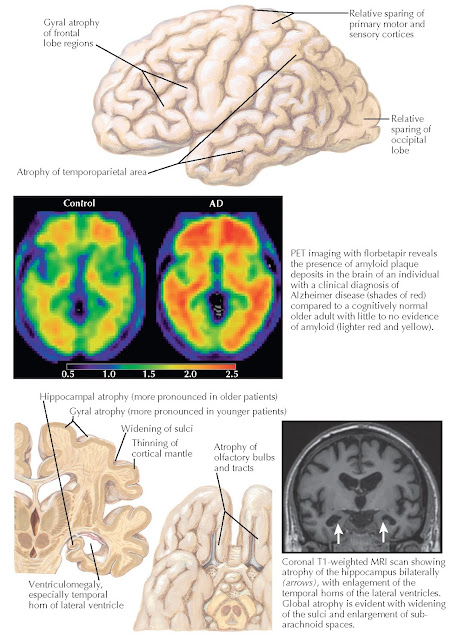ALZHEIMER DISEASE: PATHOLOGY
Alzheimer disease (AD) is the most common neurodegenerative disorder and affects 10% of people older than age 65 years and nearly 50% of those 85 years and older. The brain affected by AD has gross changes of brain atrophy accompanied by microscopic changes of amyloid plaques and neurofibrillary tangles.
The gross pathology of AD appears as
enlargement of the ventricles and widening of the sylvian fissure secondary to
cortical atrophy. Many convexal gyri are shrunken, and the sulci between these
gyri are widened. The cerebral cortex may appear thin, and the basal ganglia
are relatively small. The hippocampal region of the medial temporal lobe is
affected early in the disease process and prominent atrophy of this region is usually
observed. This region is responsible for storing new information, and its
degeneration is associated with the prominent short-term memory impairment that
is characteristic of AD.
 |
| Plate 2-24 |
Microscopic examination of the
affected regions reveals plaques and neurofibrillary tangles, the pathologic
hallmarks of AD. Plaques are primarily composed of extracellular accumulation
of insoluble amyloid protein. The amyloid hypothesis speculates that the
accumulation of amyloid is the critical trigger leading to the pathologic
changes in the brain of AD patients and results in synapse loss, inflammation,
neurofibrillary changes, and ultimately neuron death. Amyloid appears to
accumulate years before the clinical symptoms and is associated with parallel
worsening of brain atrophy. Neuroimaging techniques using positron emission tomography (PET) allow the presence and
burden of amyloid deposits in the brain to be detected using radioligand
labels. The molecular imaging of amyloid deposits has promise as a potential
biomarker for AD and possibly may allow the identification of individuals who
are still in the presymptomatic stages of the illness.
Neurofibrillary tangles are
intracellular inclusions composed of aggregated tau proteins that normally function to stabilize axonal microtubules. Tau
protein found in neurofibrillary tangles is in an abnormal state of
hyperphosphorylation, which occurs in conjunction with its dissociation from
microtubules and clumping as paired helical filaments. Neurofibrillary tangles
are a ubiquitous accompaniment of aging, and accumulate with age in a
predictable pattern. Individuals with AD tend to have more tangles, plaques,
and neuron loss than individuals without
dementia.




